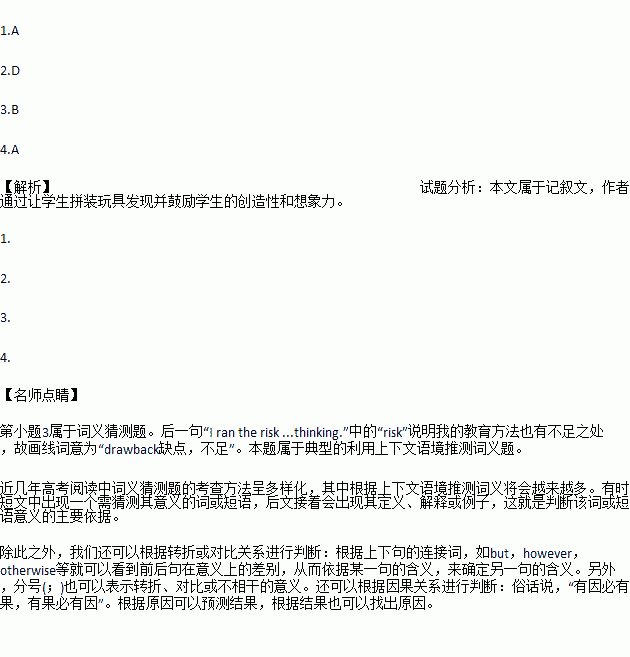题目内容
Five years ago, when I taught art at a school in Seattle, I used Tinkertoys as a test at the beginning of a term to find out something about my students. I put a small set of Tinkertoys in front of each student, and said:“Make something out of the Tinkertoys. You have 45 minutes today and 45minutes each day for the rest of the week.” A few students hesitated to start. They waited to see the rest of the class would do. Several others checked the instructions and made something according to one of the model plans provided. Another group built something out of their own imaginations.
Once I had a boy who worked experimentally with Tinkertoys in his free time. His constructions filled a shelf in the art classroom and a good part of his bedroom at home. I was delighted at the presence of such a student. Here was an exceptionally creative mind at work. His presence meant that I had an unexpected teaching assistant in class whose creativity would infect(感染) other students.
Encouraging this kind of thinking has a downside. I ran the risk of losing those students who had a different style of thinking. Without fail one would declare, “But I’m just not creative.”
“Do you dream at night when you’re asleep?”
“Oh, sure.”
“So tell me one of your most interesting dreams.” The student would tell something wildly imaginative. Flying in the sky or in a time machine or growing three heads. “That’s pretty creative. Who does that for you?”
“Nobody. I do it.”
“Really-at night, when you’re asleep?”
“Sure.”
“Try doing it in the daytime, in class, okay?”
1.The teacher used Tinkertoys in class in order to ________.
A. know more about the students B. make the lessons more exciting
C. raise the students’ interest in art D. teach the students about toy design
2.What do we know about the boy mentioned in Paragraph 3?
A. He liked to help his teacher. B. He preferred to study alone.
C. He was active in class. D. He was imaginative.
3.What does the underlined word “downside” in Paragraph 4 probably mean?
A. Mistake. B. Disadvantage.
C. Difficulty. D. Burden.
4.Why did the teacher ask the students to talk about their dreams?
A. To help them to see their creativity. B. To find out about their sleeping habits.
C. To help them to improve their memory. D. To find out about their ways of thinking.
Kurt Muller and his wife Rita have spent eleven years making (43)D for the homeless of Berlin,Germany's capital.They first (44)Aone long hot summer when most Germans (45)A on holiday.Kurt and his wife stayed at home,made sandwiches,(46)Ba table in the street and gave food to the homeless.
The Mullers soon realized that food and clothing weren't (47)B."What those people also need is warmth and (48)D,"says Rita.The Mullers didn't (49)C to give their phone number to the street people and told them to phone anytime.Rita (50)Cthere was somebody at home to answer the phone and their home was always(51)Ato anyone who couldn't face another night on the street.
The couple were soon (52)Aall their time and money,so Kurt visited food and clothing companies to (53)Adonations.Today,over thirty companies (54)Cdonate food and other goods to the cause and volunteers help to (55)Cthem to the homeless.The public also give clothes and money and a shoe producer (56)A new shoes.
Kurt and Rita receive no (57)Cfor their hard work,"we feel like parents,"says Rita,"and parents shouldn't (58)Dmoney for helping their children.The love we get on the streets is our salary."Though Rita admits she often gets(59)D,she says she will continue with her work because she likes the feeling of having made a (60)B in the world.
| 41.A.result | B.idea | C.truth | D.reason |
| 42.A.traditional | B.wealthy | C.developing | D.typical |
| 43.A.preparations | B.suggestions | C.houses | D.meals |
| 44.A.began | B.met | C.called | D.left |
| 45.A.away | B.alone | C.asleep | D.across |
| 46.A.brought up | B.set up | C.set aside | D.gave away |
| 47.A.necessary | B.enough | C.helpful | D.expensive |
| 48.A.fame | B.freedom | C.courage | D.caring |
| 49.A.pretend | B.agree | C.hesitate | D.intend |
| 50.A.made sense | B.found out | C.made sure | D.worked out |
| 51.A.open | B.crowded | C.noisy | D.near |
| 52.A.spending | B.wasting | C.costing | D.taking |
| 53.A.ask for | B.pay for | C.look into | D.carry out |
| 54.A.completely | B.calmly | C.regularly | D.roughly |
| 55.A.advertise | B.sell | C.deliver | D.lend |
| 56.A.donates | B.produces | C.designs | D.collects |
| 57.A.permission | B.direction | C.payment | D.support |
| 58.A.borrow | B.raise | C.save | D.expect |
| 59.A.surprised | B.excited | C.amused | D.tired |
| 60.A.profit | B.difference | C.decision | D.rule |

